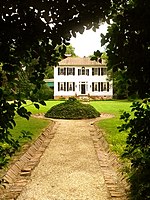Third Presbyterian Church (Greenville, South Carolina)
Akron Plan church buildingsChurches completed in 1920Churches in Greenville County, South CarolinaInfobox religious building with unknown affiliationPresbyterian churches in South Carolina

Third Presbyterian Church is a historic church in Greenville, South Carolina, restored as a place of worship by the congregation of Trinity Church of Greenville, for which the latter received a 2016 State Preservation Honor Award from the South Carolina Department of Archives and History and the Palmetto Trust for Historic Preservation.
Excerpt from the Wikipedia article Third Presbyterian Church (Greenville, South Carolina) (License: CC BY-SA 3.0, Authors, Images).Third Presbyterian Church (Greenville, South Carolina)
Pete Hollis Boulevard, Greenville Downtown
Geographical coordinates (GPS) Address Website External links Nearby Places Show on map
Geographical coordinates (GPS)
| Latitude | Longitude |
|---|---|
| N 34.860583333333 ° | E -82.405944444444 ° |
Address
Trinity Church
Pete Hollis Boulevard 100
29601 Greenville, Downtown
South Carolina, United States
Open on Google Maps









